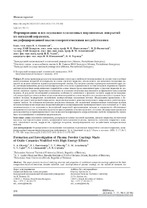| dc.contributor.author | Оковитый, В. А. | ru |
| dc.contributor.author | Пантелеенко, Ф. И. | ru |
| dc.contributor.author | Оковитый, В. В. | ru |
| dc.contributor.author | Углов, В. В. | ru |
| dc.contributor.author | Шиманский, В. И. | ru |
| dc.contributor.author | Черенда, Н. Н. | ru |
| dc.contributor.author | Асташинский, В. М. | ru |
| dc.coverage.spatial | Минск | ru |
| dc.date.accessioned | 2018-10-11T12:06:46Z | |
| dc.date.available | 2018-10-11T12:06:46Z | |
| dc.date.issued | 2018 | |
| dc.identifier.citation | Формирование и исследование плазменных порошковых покрытий из оксидной керамики, модифицированной высокоэнергетическими воздействиями = Formation and Investigation of Plasma Powder Coatings Made of Oxide Ceramics Modified with High-Energy Effects / В. А. Оковитый [и др.] // Наука и техника. – 2018. – №5. – С. 378-389. | ru |
| dc.identifier.uri | https://rep.bntu.by/handle/data/48103 | |
| dc.description.abstract | В статье приведены результаты исследования структуры и свойств оптимизированных по составу многослойных
композиционных покрытий из материалов на основе диоксида циркония, используемого для напыления плазменных покрытий на модели элементов экранов противометеорной защиты. Рассмотрено влияние параметров плазменной струи (тока, дистанции напыления, расхода плазмообразующего газа азота) и фракционного состава исходного порошка на характеристики двухслойных композиционных покрытий на основе никель-хрома-алюминия-иттрия и диоксида циркония на элементах защитных экранов. Проведена оптимизация на основании получения максимального коэффициента использования порошка. В результате исследований установлены особенности элементного и фазового составов, морфологии поверхности, микроструктуры многослойных композиционных покрытий на основе твердого слоя оксидов металлов и вязкого переходного подслоя, подвергнутых воздействию компрессионных плазменных потоков. Исследования проводились с помощью растровой электронной микроскопии, энергодисперсионного рентгеноспектрального микроанализа, рентгеноструктурного анализа. На основании полученных результатов показано, что воздействие компрессионных плазменных потоков на многослойные композиционные покрытия приводит к модифицированию приповерхностного слоя толщиной до 15 мкм,
заключающемуся в его плавлении и последующей скоростной кристаллизации, которые в совокупности обеспечивают
повышение его плотности, снижение пористости при сохранении исходного фазового состояния. Жидкофазные процессы в расплавленной фазе приповерхностного слоя позволяют модифицировать морфологические свойства поверхности, связанные с ее сглаживанием и снижением шероховатости. | ru |
| dc.language.iso | ru | ru |
| dc.publisher | БНТУ | ru |
| dc.title | Формирование и исследование плазменных порошковых покрытий из оксидной керамики, модифицированной высокоэнергетическими воздействиями | ru |
| dc.title.alternative | Formation and Investigation of Plasma Powder Coatings Made of Oxide Ceramics Modified with High-Energy Effects | ru |
| dc.type | Article | ru |
| dc.identifier.doi | 10.21122/2227-1031-2018-17-5-378-389 | |
| local.description.annotation | The paper presents results of studying structure and properties of multilayer composite coatings optimized for their
composition based on zirconium dioxide materials used for deposition of plasma coatings on the models of elements for anti-meteor shielding screens. The influence of plasma jet parameters (current, distance of sputtering, consumption of plasma-forming nitrogen gas) and fractional composition of an initial powder on characteristics of two-layer composite coatings based on nickel-chromium-aluminum-yttrium and zirconium dioxide on the elements of protective screens has been analyzed in the paper. Optimization has been carried out on the basis of obtaining maximum coefficient of powder utilization. The investigations have made it possible to ascertain specific features of elemental and phase composition, surface morphology, microstructure multilayer composite coatings on the basis of a solid layer of metal oxides and a viscous transition sub-layer subjected to compression plasma flows. The investigations have been executed with the help of scanning electron microscopy, energy dispersive x-ray spectral microanalysis, and x-ray diffraction analysis. It has been shown on the basis of the obtained results that the effect of compression plasma flows on multilayer composite coatings leads to a modification of a near-surface layer with a thickness up to 15 μm that presupposes its melting and subsequent high-speed crystallization which together provide an increase in its density, decrease in porosity while maintaining the initial phase state. Liquid-phase processes in the molten phase of the near-surface layer permit to modify morphological properties of the surface which are associated with its smoothing and lowering of roughness. | ru |

